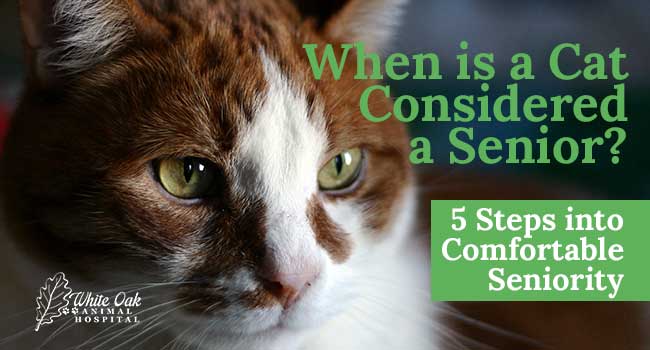
In this article, we shed light on a pivotal question for pet owners: When is a cat considered a senior? Embarking on the journey of feline companionship involves understanding the nuances of a cat’s life stages. This inquiry holds significance as it forms the foundation for tailored care and companionship. Delving into the intricacies of feline aging, we aim to demystify the transition into seniority. For pet owners, recognizing this milestone is critical to providing optimal care, addressing evolving needs, and fostering a fulfilling relationship with their beloved companions. Join us as we navigate the subtle markers of seniority and equip you with essential insights for your cat’s well-being.
When Is a Cat Considered a Senior?
Changes to Expect as a Cat enters their Senior Years
As our beloved feline companions enter their golden years, understanding the subtle changes accompanying this transition becomes paramount for pet owners. “When is a cat considered a senior?” you might ask. Generally, cats are considered seniors after age 8-10, a milestone marked by physical and behavioral transformations.
Physical Changes
- Weight fluctuations, often towards reduced muscle mass, become familiar.
- Their coat may become thinner or coarser, and the skin may lose elasticity.
- Mobility issues, such as arthritis or joint stiffness, can affect their ability to move quickly.
Behavioral Shifts
- Altered sleep patterns, with longer sleep duration and changes in sleep-wake cycles, become evident.
- A natural slowing down occurs, leading to an overall decrease in activity levels.
- Grooming habits may become less meticulous, influencing their overall appearance.
Tailored Care
- Regular veterinary check-ups are crucial to monitor and address emerging health issues.
- Tailoring nutritional needs, creating a supportive environment, and adopting a compassionate approach significantly contribute to maintaining a senior cat’s well-being and quality of life.
Impact on Nutritional Needs
Understanding the answer to “When is a cat considered a senior?” is pivotal for addressing their evolving nutritional needs. As cats age, the impact on their dietary requirements becomes pronounced. Pet owners must delve into the nuances of these changes to ensure their feline companions receive the best possible care.
Senior cats may benefit from diets specifically formulated to address age-related health concerns like joint health and weight management. Providing a well-rounded and tailored diet becomes a cornerstone in supporting their overall well-being. By grasping the significance of knowing the answer to “When is a cat considered a senior?” pet owners can make informed choices that contribute to the health and longevity of their cherished feline friends.
5 Steps into Comfortable Seniority
Their needs change as cats reach their senior years, typically around 8-10. Cat owners can take steps to ensure their aging felines remain healthy and comfortable. When is a cat considered a senior? Generally around 8-10 years old. By being proactive and implementing simple practices, pet owners can ease their cats into senior status. Here are five steps to help senior cats live their best lives.
Adjust Their Diet
One of the most important things pet owners can do for senior cats is to adjust their diet. When is a cat considered a senior from a dietary perspective? Usually around 8-10 years old. As cats age, their metabolism changes. Senior cats need food that is highly digestible and nutrient-dense. Switching to a high-quality wet food made especially for mature cats can make eating easier on aging teeth and digestion. Senior cat formulas have increased protein and reduced fat to maintain lean body mass. Reduced phosphorus prevents kidney issues. Increased omega fatty acids improve skin and coat health.
Schedule Veterinary Check-ups
Encourage Impact Exercise
Exercise remains important for senior cats, just modified to their abilities. When is a cat considered a senior in terms of activity needs? Around 8-10 years old. Low-impact activities allow aging cats to maintain muscle tone and joint health without overexertion. Try engaging cats with toys that encourage batting and chasing without jumping. Laser pointers offer stimulation without strain. Place climbing structures near resting areas so senior cats don’t have to go far. Massage and stretching increase circulation and flexibility. Outdoor cats may need to go indoors only if roaming becomes difficult. Adjust exercise to a senior cat’s limits to optimize their physical function.
Add Comfort Features
Give More TLC
While cats are still self-sufficient as seniors, a little more TLC can lift their spirits. When is a cat considered a senior in terms of emotional needs? Around 8-10 years old. Spend more one-on-one time petting, brushing, and interacting with aging cats. Cats approaching the end of life need extra affection. Encourage play and movement at their pace. Maintain routines to offer stability as cats deal with cognitive changes. Consider adopting a younger cat as a companion. Avoid introducing significant household changes. Working extra snuggles into the daily schedule helps senior cats feel loved.
The transition into the senior years marks a new life stage for cats. When is a cat considered a senior? Generally at the ages of 8-10 years old. With minor adjustments to their care, aging pets can continue living joyful, comfortable lives. Simple diet changes, proactive veterinary visits, low-impact exercise, comfort features, and extra affection keep senior cats purring. Understanding senior cats’ needs allows owners to be prepared and provide the best support. Embracing the aged years with some essential tips enhances cats’ golden years.